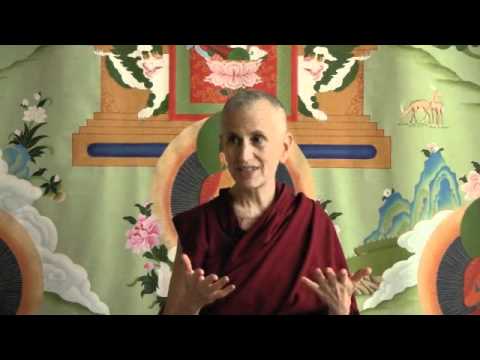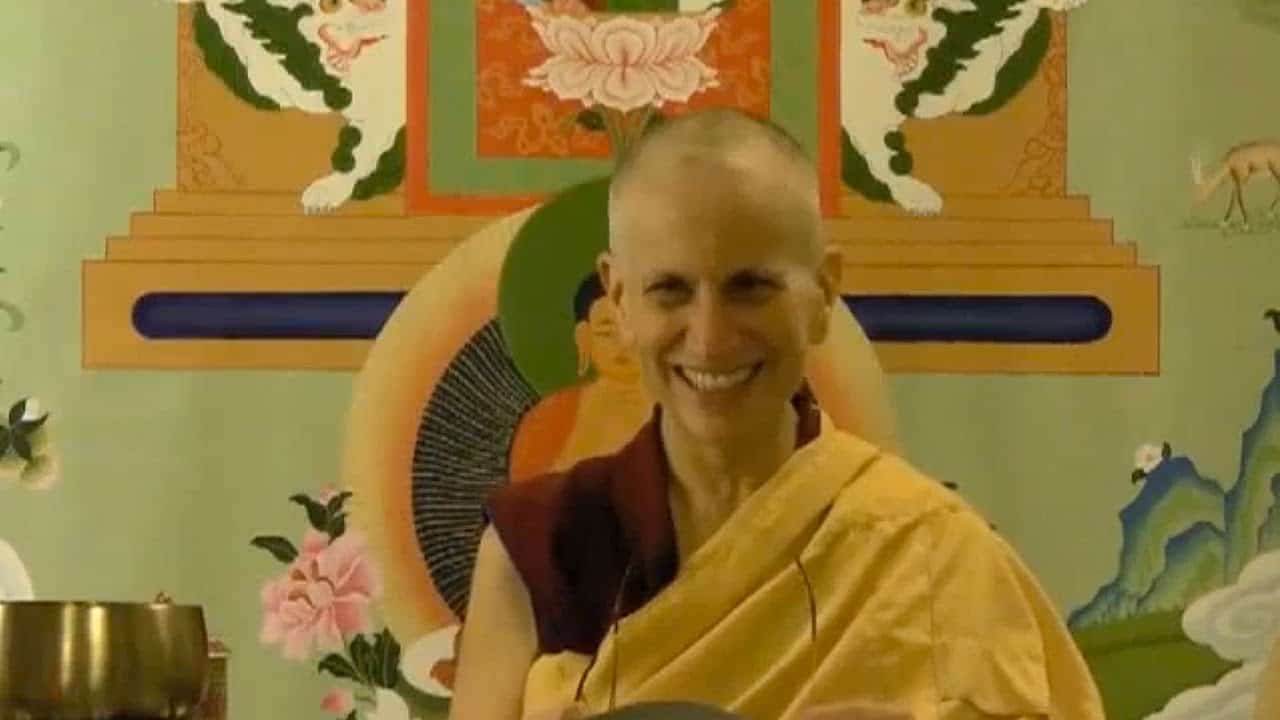How to recite mantra
This talk was given during the White Tara Winter Retreat at Sravasti Abbey.
- How to recite the mantra
- Using a mala to count mantra
- Keeping our focus while visualizing and reciting
- What to do when we make mistakes
White Tara Retreat 23: Mantra recitation (download)
When we recite the mantra, there are various ways to recite it. When you are with a group, often people chant it out loud: om tare tuttare ture soha. When you say it to yourself, you usually don’t use that melody when you chant it—unless you are walking around at the break time (or something like that) to relax your mind and you are chanting out loud. Then you can use the melody. If you are saying the mantra to accumulate the mantra (to say a lot of them), then you usually just say it in a monotone, om tare tuttare ture soha, or, om tare tuttare ture mama ayur punye jnana pushtim kuru soha, om tare tuttare ture mama ayur punye jnana pushtim kuru soha.
They say that when you are doing retreat, and you are accumulating the mantra, you don’t say it out loud so that the person sitting next to you can hear you—even if you are doing a solitary retreat—not that loud. You don’t usually say it with your mouth completely closed either. You say it by mouthing the words so the sound is between the teeth and the lips. It should not go out so another person hears it. Some people move their lips in a very noisy way, so you have to be careful about that. If that is disturbing to the person next to you then, just close your mouth and do it silently. Normally then you would do it by not mouthing the words in a big way, but in a small way, and with some kind of tiny sound.
Using malas
You use your mala to count the beads. That is why you have a mala. A mala isn’t for decoration. It’s not to go around and show everybody that you are a Buddhist. And, by the way, if you wear your mala, you usually put it around your wrist. You don’t put it around your neck like a necklace.
If you go to the bathroom, you take it off. You don’t take your mala into the bathroom with you. Here at the Abbey, we don’t wear our malas in any way because I think it is just much clearer that way. (This is) because I’ve noticed that people sometimes can get very attached to their mala and say, “Look, I have this beautiful mala with this nice tassel, and these counter beads hanging here, and I wear it around my wrist; it’s almost, not quite, (but actually it is) jewelry”—jewelry in the name of Dharma. Since as monastics one of our precepts is not to wear jewelry, then we don’t wear our mala. That is the same reason why we don’t wear our watch here at the Abbey. Often a watch, although a pragmatic thing to have, can also be a piece of jewelry that adorns the body.
In any case, if you are counting mantra then you use your mala. You use your mala very quietly, you don’t click it—click, click, click—so that everybody in the hall can hear. If there is a short mantra like om tare tuttare ture soha, it goes by very quickly. Keep track of the number of complete malas you have recited. Sometimes there are counters (little strings on the mala) but sometimes what I think is easier is this. You have little pebbles, or whatever you can find, in front of you. Then with every mala you just move one pebble from one bowl to the next. You can also—because sometimes even that is difficult with a short mantra, because it goes by so quickly—you might do, let us say three recitations of the mantra for each bead. Then you don’t have to move the beans, pebbles, or whatever so frequently.
Attention while reciting mantra
When you are reciting the mantra try to keep your mind on the visualization. As I have said [in previous talks], if the mantra is prominent then the visualization will be more in the background. If the visualization is prominent, the mantra will be in the background. We have the ability to do that. It’s like watching TV. Sometimes you watch the picture and the music is in the background. Sometimes the music is so interesting, (as when you are listening to a symphony) that you listen to the music and the people playing on the instruments are in the background in terms of your attention.
Keep your mind on what you are doing. Sometimes when you are trying to do 100,000 of the mantra—which I have suggested that everybody on the retreat try to do at least that many—then they say if you get distracted you start that mala over. For example, if you cough or you burp, you start it over. If we held to all of those things we probably would never get more than one mala done! So I usually start over if the distraction is really bad. You can become strict with yourself as time goes on and you become more concentrated; you can really stay on it more.
Mistakes in recitation
Then at the end of saying your mantras, you often say the Vajrasattva mantra as a way of purifying any incorrect ways that you have of saying the mantra. I remember when I was first receiving instruction on how to do a mantra in retreat, they say, “Make sure you are doing the mantra that pertains to that deity.” I thought, “Of course! How can anybody ever get mantras mixed up?!” Well, over the years I have found out that you can be meditating, supposedly meditating, on one deity and reciting the mantra of another deity because you are spaced out. Clearly then you have to start that mala over because you are not even doing the right deity mantra! So saying the Vajrasattva mantra at the end purifies those kinds of mistakes.
Sometimes if it is a long mantra, you leave out parts of it or you get it garbled. You may say, “Om tare tuttare mama ayur punye jnana…” and you forget, “Om tare tuttare TURE mama ayur punye jnana pushtim kuru soha.” Or the end of the mantra gets left off, “om tare tuttare ture mammm SOHA, om tare tuttare ture mammm SOHA,” and the last five or six syllables, or three or four syllables get condensed. You want to make sure that you enunciate each syllable. It doesn’t have to be, OM-TA-RE-TU-TA-RE… But, it is important that you get all the syllables in and they are clear and not mumbled, versus where everything gets compressed.
It is similar to how some people mumble when they talk. When they say a sentence you get the first part of the sentence, and then the last part has disappeared somehow. You want to make sure that you get the whole thing when you are reciting the mantra.
Venerable Thubten Chodron
Venerable Chodron emphasizes the practical application of Buddha’s teachings in our daily lives and is especially skilled at explaining them in ways easily understood and practiced by Westerners. She is well known for her warm, humorous, and lucid teachings. She was ordained as a Buddhist nun in 1977 by Kyabje Ling Rinpoche in Dharamsala, India, and in 1986 she received bhikshuni (full) ordination in Taiwan. Read her full bio.


